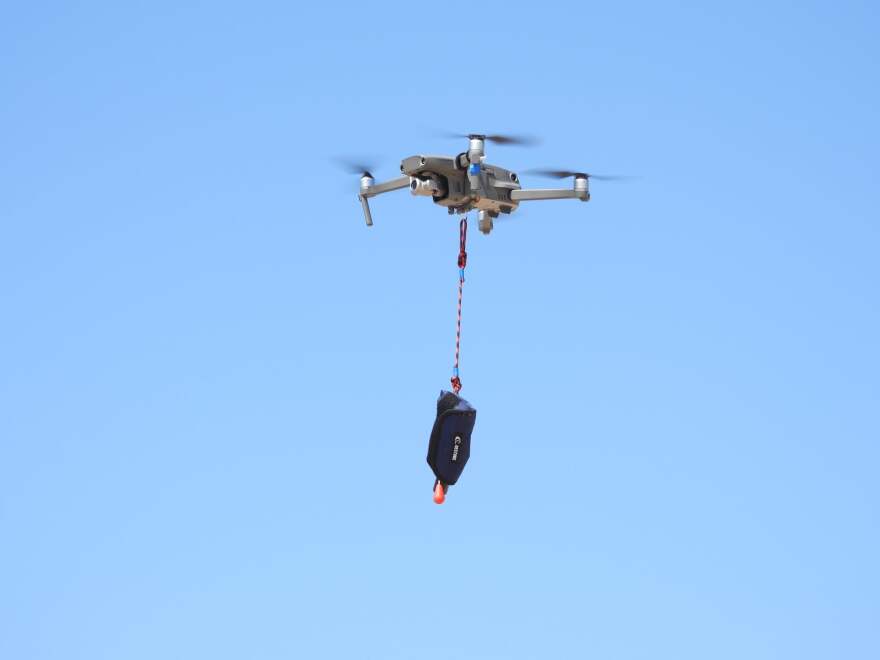Ocean swimming can be dangerous and many beaches have lifeguards at the ready. But that’s not the case for most beaches along the Great Lakes.
After a record number of drownings on Lake Michigan last year, South Haven is getting creative with its water rescues.

South Haven sits right on the shores of Lake Michigan. The city has two main public beaches and a popular lighthouse – an idyllic setting that attracts tens of thousands of tourists every summer.
But like other areas along the Great Lakes, swimming here can be dangerous because of rip currents and strong waves. And swimmers who are unfamiliar with them can get in trouble.
“It’s the out of town people who come here on vacation and things like that that we need to work on educating,” says Zachary Kenreich, a firefighter and paramedic with South Haven Area Emergency Services.
Last year his team responded to 23 water rescues on Lake Michigan, and three people drowned.
That’s when Kenreich started brainstorming on ways his department could cut down on its response time for people struggling in the water.
And what he came up with was a drone.
Thanks to a $7,500 grant, the department was able to buy a special drone outfitted with some unique features.

It’s about the size of a frisbee and is equipped with a high-tech camera. Dangling from the center of it is a small folded-up flotation device, which can be released remotely by the drone operator.
Once it hits water, a CO2 canister automatically inflates a 3'x6" yellow flotation tube, big enough to support an adult.
Drones dropping inflatables have been popular in Australia for a few years now. And this year, some beaches in California and Florida are also starting to deploy them.
“We have tested it multiple times,” Kenreich explains. “It’s been working very well for us, and this doesn’t change anything that we do normally.”

But not everyone is gung-ho about these drones.
“This inflatable device would almost literally have to be dropped on their head or in their hands,” says Dave Benjamin, the executive director of the Great Lakes Surf Rescue Project.
If it’s not, the victim might not be able to reach the flotation device or waves could carry it to shore without them.
“Oftentimes a drowning victim will not be able to reach out for help,” Benjamin says. “They’re doing the instinctive drowning response; they’re fighting to survive.”
Still, in South Haven, it normally takes SHAES responders around eight minutes to get from the station, to the beach, and then to the victim in the water.
That’s pretty quick, but in a drowning scenario, every second counts. And the drone can get help to the swimmer faster.
It can fly around 40 mph and can reach a victim about three minutes quicker than a rescue swimmer.
“It is a quick way to get a flotation device out to a victim,” says BJ Fisher, director of health and safety at the American Lifeguard Association.
“And it’s very important that that is done as quickly as possible,” he says.
Fisher says integrating more technology into these rescue operations is a good thing, but installing more lifeguards at beaches would still be the best option.
But that can be challenging for tourist cities like South Haven, which face staffing shortages and have liability concerns about using lifeguards.
“It won’t solve the problem, but it’s better than nothing,” admits Fisher regarding the drone.”
With July right around the corner, more and more people are going to be getting in the Great Lakes.
For the emergency services team in South Haven, they hope this new drone means fun days at the beach won’t turn tragic.

With 56 known drownings on Lake Michigan last year, many ask, “Why aren’t more lifeguards stationed on Great Lakes beaches?”
According to a report from MLive last year, only two communities have lifeguards on the lake: Silver Beach in St. Joseph and New Buffalo Beach.
But that hasn’t always been the case. Many places along Lake Michigan had lifeguards in the past, but now have moved toward warning signs and flag systems.
Some communities say they just followed the state’s lead when it pulled lifeguards from state beaches in the early 1990s.
“The main reason at that time was liability issues,” says Ron Olson, chief of parks and recreation for the Michigan Department of Natural Resources.
“Because there’s an expectation when you have supervision of an area that people will, in effect, be safeguarded all the time.”
Olson says another reason the state beaches don’t have lifeguards is because they can’t find enough of them.
“We’re having a hard time just keeping our summer workers working in the parks,” he explains.

Olson doesn’t use the word “babysitting” when it comes to monitoring people on the beach – he says that sounds too trivial. But he does say that swimmers need to take responsibility for their actions, especially in the outdoors.
“People need to understand that we can’t supervise all of people’s choices and what they choose to do in recreation,” Olson says. “What we do is, we enable places to go but we also try to reasonably warn people not to do things.”



